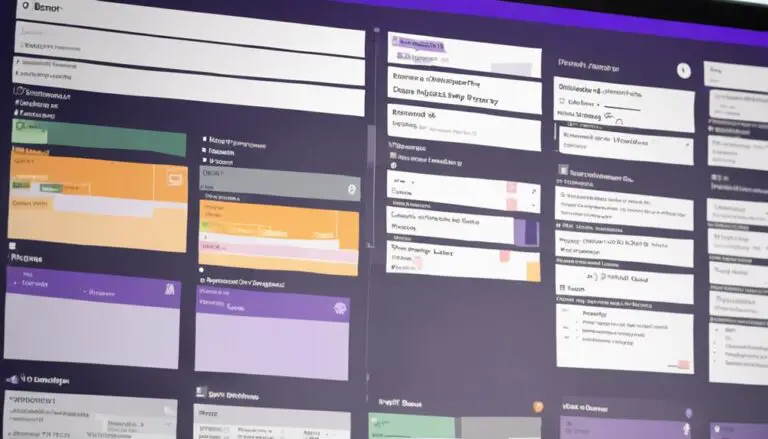Did you know that teams using Kanban combined with sprints are 56% more likely to deliver projects on time?
Embracing the synergy between these methodologies can significantly boost your project's success rate.
By mastering the art of sprint planning within a Kanban framework, you can unlock a world of possibilities for optimizing your team's efficiency and output.
Stay tuned to discover the key strategies and elements that will pave the way for your sprint success in Kanban. By understanding and implementing the kanban sprint strategies, you can effectively manage your workflow and optimize your team’s productivity. With a focus on visualizing workflow, limiting work in progress, and continuously improving your processes, you can achieve greater efficiency and success in your sprint cycles. Keep these key elements in mind as you navigate the kanban framework, and you’ll be well on your way to sprint success.
Key Takeaways
- Clear sprint goals are essential for focus and alignment.
- Effective task management ensures streamlined progress and goal attainment.
- Continuous improvement fosters team growth and process optimization.
- Tailoring sprint practices to team preferences enhances success.
Benefits of Combining Sprints With Kanban
By integrating sprints with Kanban, you can enhance project planning agility and flexibility, creating a harmonious balance between structured goals and dynamic task management. This fusion of Scrum and Kanban methodologies allows for improved sprint planning while leveraging flow metrics for better workflow visualization and optimization. The time-boxed nature of sprints within the continuous flow of Kanban enables teams to focus on short-term objectives while maintaining a steady pace of task completion.
With sprint planning integrated into the Kanban framework, you can benefit from the predictability and adaptability offered by Scrum, while also harnessing Kanban's emphasis on continuous delivery and workflow efficiency. This combination fosters a collaborative environment where teams can adjust priorities based on real-time feedback and performance metrics, leading to enhanced productivity and delivery speed. By merging sprints with Kanban, you're embracing a structured yet flexible approach to project management that empowers teams to achieve their goals effectively and efficiently.
Key Elements for Sprint Success in Kanban
You're on track for sprint success with clear goals, smart task management, and a mindset geared towards continuous improvement.
Let's ensure that your sprint is laser-focused on achieving those well-defined objectives.
Keeping an eye on these key elements will pave the way for a productive and successful sprint in Kanban.
Clear Sprint Goals
Setting clear sprint goals is crucial for the success of Kanban teams as it provides a focused direction for achieving specific objectives within defined timeframes.
In Kanban sprints, having clear objectives ensures that everyone is on the same page about what needs to be accomplished during the sprint. These goals should be measurable and achievable, helping in tracking progress and determining the success of the sprint.
By outlining clear sprint goals, you provide a roadmap for your team, guiding them on which tasks to prioritize and complete. This clarity enhances team alignment, collaboration, and overall productivity, driving towards the desired outcomes.
Well-defined sprint goals are fundamental for effective sprint planning and execution in Kanban, fostering continuous improvement and successful project delivery.
Effective Task Management
For successful sprint outcomes in Kanban, effective task management serves as a cornerstone, ensuring streamlined progress and goal attainment within defined timeframes.
Utilize Kanban boards to organize tasks visually, track progress, and maintain transparency. Assign clear task priorities and deadlines in Kanban columns to facilitate task completion during sprints efficiently.
Implementing Work In Progress (WIP) limits on the Kanban board helps control the number of tasks in progress, enhancing focus and productivity.
Keep the team informed by monitoring and updating task statuses in real-time on the Kanban board, enabling everyone to stay on track for sprint success.
Regularly review and adjust task assignments based on sprint progress to optimize task management and achieve sprint goals effectively.
Continuous Improvement Mindset
To cultivate a continuous improvement mindset for sprint success in Kanban, embracing feedback and adaptation as integral components is paramount. In Kanban Sprints, conducting retrospective meetings after each cycle allows teams to reflect on their performance, identify what worked well, and pinpoint areas for improvement.
By analyzing metrics such as lead time, cycle time, and throughput, teams can measure their efficiency and progress accurately. Encouraging team members to actively participate in suggesting and implementing process improvements fosters a culture of continuous growth.
It's essential to emphasize the importance of incremental changes and learning from mistakes to enhance flow and drive continuous improvement within Kanban Sprints. Stay committed to this mindset to achieve ongoing success and evolution in your sprint practices.
Sprint Length Considerations in Kanban
When considering sprint length in Kanban, tailor the duration to suit your team's preferences and project needs. In Kanban, you have the flexibility to choose between different sprint lengths based on what works best for your team.
Some teams prefer shorter sprints, like one week, to enable faster feedback loops and adaptability. On the other hand, longer sprints, such as two weeks or more, can allow for a deeper focus on complex tasks and larger deliverables.
It's essential to consider your team's capacity, cycle time, and the nature of your projects when deciding on the sprint length. Experimenting with different sprint lengths can help you find the optimal cadence that aligns with your team's goals and enhances productivity.
Implementing Sprint Planning in Kanban
Let's kick off the discussion on implementing sprint planning in Kanban by focusing on the key points like understanding the basics of sprint planning and setting up a Kanban board.
This will help streamline your workflow and visualize the progress of tasks during the sprint.
Sprint Planning Basics
In implementing Sprint Planning in Kanban, the team focuses on breaking down tasks into smaller deliverables to enhance workflow clarity and optimize performance. By utilizing the Kanban methodology, teams working on mature products can effectively integrate sprint planning with Kanban practices to optimize their workflow.
During sprint planning sessions, team members like the Scrum master, product owner, and developers collaborate to define specific time periods for task completion within a Sprint. This process ensures that tasks are well-defined, manageable, and align with the team's capacity.
Kanban Board Setup
To set up a Kanban board for implementing Sprint Planning in Kanban, begin by establishing columns that represent different stages of the sprint planning process. Here are some key steps to consider:
- Utilize swimlanes to categorize tasks based on priority, team member, or type of work for improved organization.
- Assign specific WIP (work in progress) limits to each column to regulate task flow and prevent overloading team members.
- Include a sprint backlog column on the Kanban board to visualize planned tasks for the current sprint and monitor their progress effectively.
Managing Work-in-Progress in Kanban Sprints
Managing Work-in-Progress in Kanban Sprints requires setting explicit WIP limits at each stage of the workflow to enhance efficiency and maintain focus. By implementing WIP limits, you can prevent task overload, ensure smoother task progression, and optimize workflow in Kanban Sprints.
Monitoring WIP levels on your Kanban board during Sprints is crucial to balancing workloads effectively. Adjusting WIP limits based on your team's capacity and identifying bottlenecks will significantly enhance your team's productivity. It's essential to find the right balance between WIP limits, team capacity, and workload distribution to keep your Kanban Sprint running smoothly.
Tracking Sprint Progress in Kanban
Enhance your Kanban Sprint efficiency by effectively tracking sprint progress using visual cues on the Kanban board. To ensure you're on the right track, consider the following:
- Visualize Tasks: Utilize columns on the Kanban board to represent different stages of completion for product backlog items, providing a clear visual indication of progress.
- Utilize Swimlanes: Implement swimlanes to segregate tasks by team member or priority, aiding in better tracking of sprint progress and ensuring a focused approach.
- Set WIP Limits: Establish work in progress (WIP) limits on the Kanban board to regulate the number of tasks being worked on simultaneously, maintaining a steady flow and enabling efficient tracking of progress metrics.
Continuous Improvement Strategies in Kanban Sprints
Implementing feedback loops in Kanban sprints allows for continual process adjustments based on team performance, fostering a culture of continuous improvement and shared responsibility. By incorporating feedback loops, teams can gather insights on what's working well and what needs enhancement, enabling them to adapt swiftly and effectively.
This continuous improvement approach empowers teams to take ownership of their processes and encourages a mindset of ongoing growth. Embracing data-driven decision-making further enhances this process, as teams can analyze metrics to make informed choices that drive improvements and streamline workflow efficiency.
Team Collaboration Techniques for Kanban Sprints
To foster effective team collaboration in Kanban sprints, prioritize daily stand-up meetings for synchronization and task updates. Here are three key techniques to enhance your team collaboration:
- Utilize Kanban Boards: Use Kanban boards to visually represent tasks, their progress, and any bottlenecks. This transparency fosters better communication and keeps everyone aligned on the team's goals.
- Set WIP Limits: Implementing Work In Progress (WIP) limits ensures that team members focus on a manageable number of tasks at a time. This prevents overload, encourages task completion, and enhances overall team efficiency.
- Embrace Continuous Improvement: Cultivate a culture of continuous improvement within your team. Encourage open feedback, regularly review processes, and iterate on ways to enhance collaboration and productivity. By continuously seeking ways to work better together, your team can achieve higher levels of success in Kanban sprints.
Evaluating Sprint Performance in Kanban
Evaluate sprint performance in Kanban by utilizing flow metrics such as cycle time, lead time, and throughput to gain insights into your team's efficiency and productivity. By measuring these flow metrics, you can track how long it takes for tasks to move from start to finish, identify any bottlenecks or delays, and optimize your workflow for better task delivery. Additionally, analyzing the completion rate of tasks within a sprint allows you to assess the efficiency of your team and make informed decisions for process improvement.
Implementing WIP limits is crucial in evaluating sprint performance as they help prevent overloading the team with too many tasks at once, leading to smoother flow and increased productivity. Monitoring task aging is also essential as it allows you to identify tasks that have been in progress for too long, indicating potential issues that need to be addressed promptly to keep the sprint on track. By using data from sprints in Kanban, you can continuously refine your processes and enhance your team's performance effectively.
Frequently Asked Questions
How Do I Manage Sprints in Kanban Board?
To manage sprints in Kanban effectively, start with sprint planning, prioritize tasks, have daily stand-ups, analyze after each sprint for continuous improvement. Set clear goals, assign tasks, track progress, and adapt as needed on your Kanban board.
Can You Do Sprints With Kanban?
Yes, you can do sprints with Kanban to incorporate agile practices and Scrum methodology. Sprint planning enables team collaboration and iterative improvements, enhancing workflow clarity. Integrating Kanban with sprints boosts efficiency and task control for successful project management.
How to Do Sprints Effectively?
In sprint planning, maximize team collaboration for effective time management. Embrace continuous improvement by adapting goals based on progress. Stay agile, tweak tasks as needed, and watch your Kanban board flourish with productivity.
How Do You Run Kanban Effectively?
To run Kanban effectively, ensure sprint planning aligns tasks, coordinate with the team for smooth workflow, track time for efficiency, and foster continuous improvement. Collaborate, adapt, and iterate to optimize processes and enhance team synergy.
Conclusion
Congratulations on successfully integrating sprints into your Kanban workflow!
Remember, 'Rome wasn't built in a day.' Continually evaluate and improve your processes, collaborate with your team, and adapt to changes as needed.
By combining the principles of Kanban with the structure of sprints, you're on your way to achieving greater efficiency and productivity.
Keep up the great work and embrace the journey towards success!





